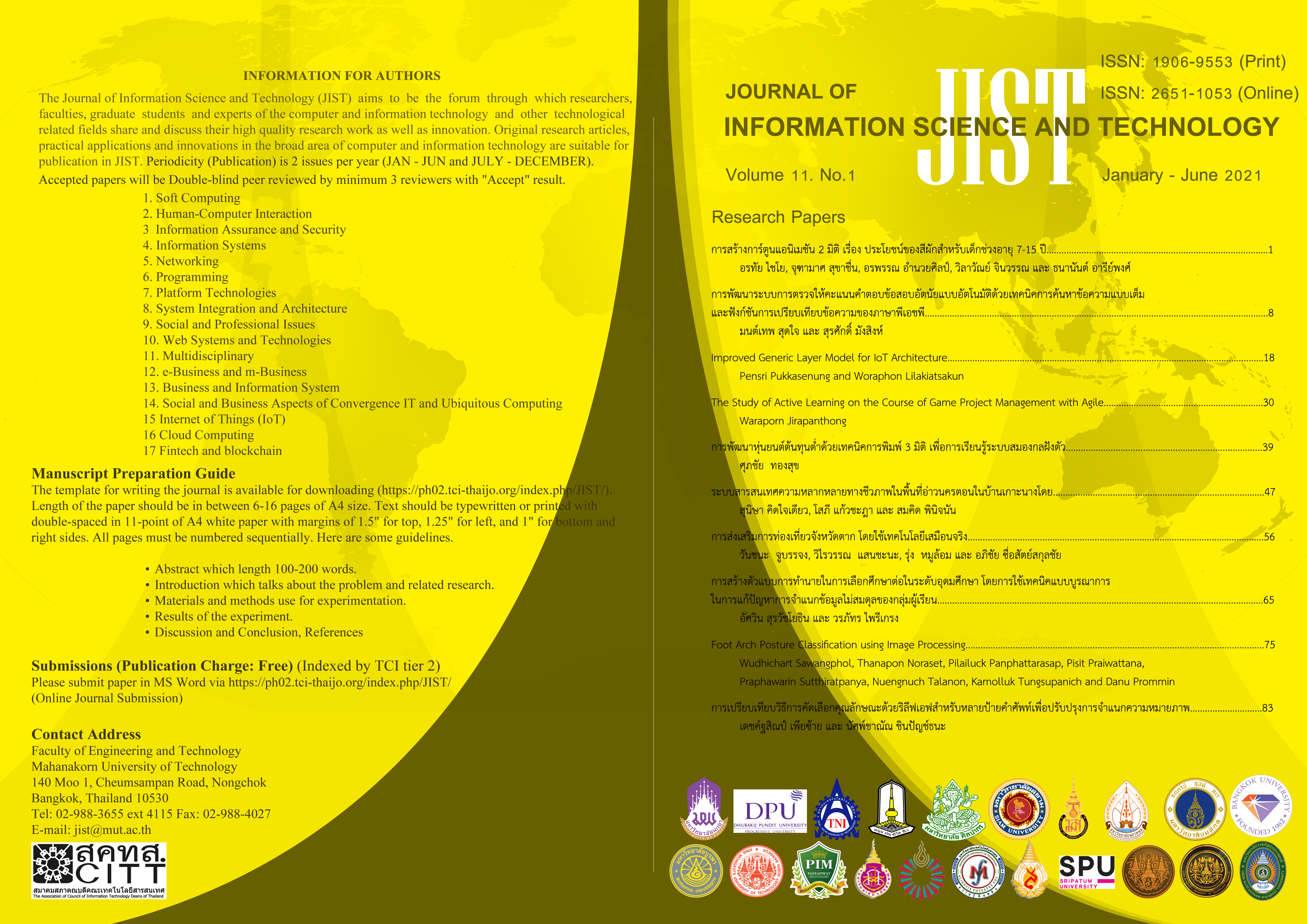Development of low cost 3D printing robot for learning embedded system
Main Article Content
Abstract
This research aimed to 1) design and develop the robot with a 3D printing technique, 2) to evaluate performance of low cost robot for learning embedded system, and 3) to evaluate the achievement in the study of learning embedded system using low cost robot. According to the sample group of this research, there were5 specialists in computer, and 50 secondary-students who attend the project. Additionally, the instrument used in this research are the questionnaire and the learning achievement test. As a result, it was presented that 1) the development result had robot characteristics which resembles human consisting of the upper part named head, body, and arms. The lower part had wheel moving part and line tracking sensors. The robot structure was printed with 3D printer using the PLA plastic. 2) the performance evaluation result found that the overall of the design and the development of the robot were in the ‘good’ level with a mean of 4.40 and a standard deviation of 0.50 3) learning achievement of students after learning was higher than the mean score of pre-learning with 0.05 level of statistical significance.
Article Details
This work is licensed under a Creative Commons Attribution-NonCommercial-NoDerivatives 4.0 International License.
I/we certify that I/we have participated sufficiently in the intellectual content, conception and design of this work or the analysis and interpretation of the data (when applicable), as well as the writing of the manuscript, to take public responsibility for it and have agreed to have my/our name listed as a contributor. I/we believe the manuscript represents valid work. Neither this manuscript nor one with substantially similar content under my/our authorship has been published or is being considered for publication elsewhere, except as described in the covering letter. I/we certify that all the data collected during the study is presented in this manuscript and no data from the study has been or will be published separately. I/we attest that, if requested by the editors, I/we will provide the data/information or will cooperate fully in obtaining and providing the data/information on which the manuscript is based, for examination by the editors or their assignees. Financial interests, direct or indirect, that exist or may be perceived to exist for individual contributors in connection with the content of this paper have been disclosed in the cover letter. Sources of outside support of the project are named in the cover letter.
I/We hereby transfer(s), assign(s), or otherwise convey(s) all copyright ownership, including any and all rights incidental thereto, exclusively to the Journal, in the event that such work is published by the Journal. The Journal shall own the work, including 1) copyright; 2) the right to grant permission to republish the article in whole or in part, with or without fee; 3) the right to produce preprints or reprints and translate into languages other than English for sale or free distribution; and 4) the right to republish the work in a collection of articles in any other mechanical or electronic format.
We give the rights to the corresponding author to make necessary changes as per the request of the journal, do the rest of the correspondence on our behalf and he/she will act as the guarantor for the manuscript on our behalf.
All persons who have made substantial contributions to the work reported in the manuscript, but who are not contributors, are named in the Acknowledgment and have given me/us their written permission to be named. If I/we do not include an Acknowledgment that means I/we have not received substantial contributions from non-contributors and no contributor has been omitted.
References
E. Guizzo, “What Is a Robot?,” 1 August2018. [Online]. Available:https://robots.ieee.org/learn/what-is-a-robot/ [Accessed: 25 May 2020]
S. Otarawanna, “The Use of 3D Printing Technology in Manufacturing Industry,” 7 November2017. [Online]. Available:https://www2.mtec.or.th/th/e-magazine/admin /upload/303_24.pdf [Accessed: 25 May2020]
T. Theeramunkong, “Embedded technology for development of embedded system,” Bangkok:Technology promotion association (Thailand-Japan), 2007.
W. Wolf and J. Madsen, "Embedded systems education for the future," in Proceedings of the IEEE, vol. 88, no. 1, pp.23-30, Jan, 2000. doi: 10.1109/5.811598.
H. Cheng and G. Ji, "Design and implementation of a low cost 3D printed humanoid robotic platform," IEEE International Conference on Cyber Technology in Automation, Control, and Intelligent Systems (CYBER), Chengdu, pp.86-91, 2016.
Matthieu Lapeyre, Pierre Rouanet and Pierre-Yves Oudeyer, “The Poppy Humanoid Robot: Leg Design for Biped Locomotion,” IEEE/RSJ International Conference on Intelligent Robots and Systems, Tokyo, Japan, Nov 2013.
T. Lin et al., "Design of a low-cost, open-source, humanoid robot companion for large retail spaces," IEEE Systems and Information Engineering Design Symposium (SIEDS), Charlottesville, VA, pp.66-71, 2016.
Likert, R., “A technique for the measurement of attitudes,” Archives of Psychology, pp.5-53, 1932.
Shelly, G.B. & Rosenblatt, H.J., “Systems Analysis and Design (9th ed.),” USA: Course Technology, Cengage Learning, 1932.



